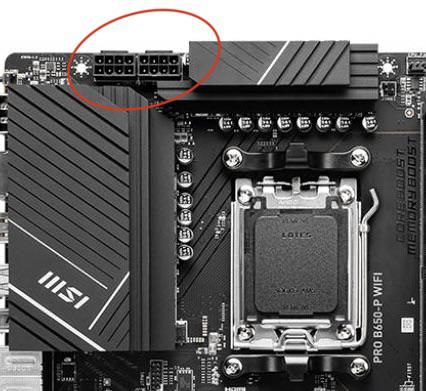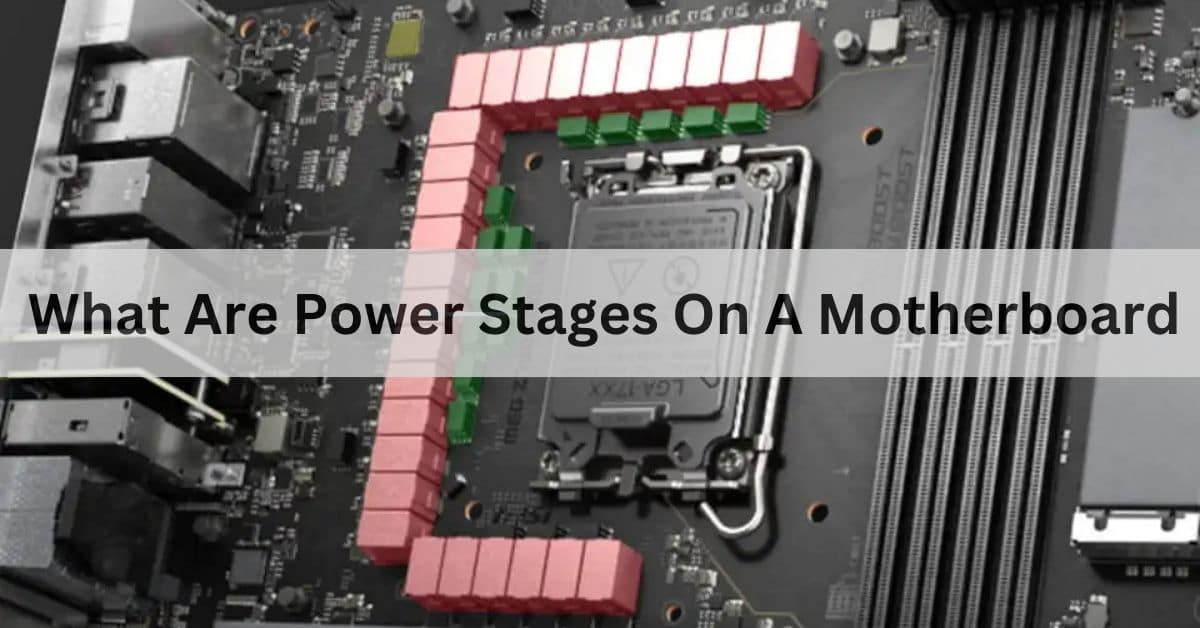When I upgraded to a motherboard with more power stages, I noticed my PC ran smoother during gaming. It made me realize how important power stages are for stable performance and power delivery.
Power stages on a motherboard help control and deliver power to the CPU. They ensure smooth and stable performance, especially during demanding tasks. More power stages often mean better power management and improved system stability.
In this article, we will discuss “What Are Power Stages On A Motherboard”.
Table of Contents
What is a motherboard?
A motherboard is a main circuit board in a computer that connects all the parts together, such as the CPU, memory, and storage. It allows these components to communicate and work as a complete system.
What is a power stage?
A power stage is a component on a motherboard that helps supply power to the CPU. It controls and regulates the voltage, ensuring the CPU receives stable power for better performance and efficiency.
What Are Power Stages on a Motherboard?

Power stages on a motherboard help manage the power that goes to the CPU. They make sure the CPU gets the right amount of power, which helps keep the computer stable and running smoothly, especially during heavy tasks.
Read More: Can A Motherboard Bottleneck – What You Need To Know!
How Many Power Stages Should a Good Motherboard Have?
A good motherboard should have at least 8-12 power stages for stable performance, especially in gaming or heavy tasks. More power stages can help keep the system cooler and deliver better power to the CPU.
Why Are Power Stages Important for a Motherboard?
Power Delivery Efficiency:
Power delivery efficiency refers to how well a motherboard sends power to its components. Better efficiency means less wasted energy and cooler temperatures, which can lead to improved performance and longer lifespan for the parts in your PC.
System Stability:
System stability means your computer runs smoothly without crashes or freezes. It ensures all parts work well together, making your tasks easier, whether gaming, browsing, or working on projects. Good stability leads to better performance.
Overclocking Capability:
Overclocking capability refers to how much you can increase a CPU or GPU’s speed beyond its normal limits. This can boost performance for gaming and other tasks, but it may also create more heat.
How Do Power Stages Affect a Motherboard’s Performance?
Power stages affect a motherboard’s performance by providing stable power to the CPU. More power stages improve efficiency and help prevent overheating, which leads to smoother operation and better performance during demanding tasks like gaming and multitasking.
Stability Under Load:
Stability under load refers to how well a motherboard handles heavy tasks, like gaming or video editing. A stable motherboard prevents crashes and keeps performance smooth, ensuring your system runs efficiently during demanding activities.
Thermal Management:
Thermal management is the process of controlling heat in a computer. It helps keep components cool, preventing overheating and damage. Good thermal management ensures your PC runs smoothly and lasts longer.
Types of Power Stages:
Integrated Power Stages:
Integrated power stages are built into the motherboard. They help supply stable power to the CPU. This makes your computer run better and more efficiently, especially when doing demanding tasks like gaming or video editing.
Discrete Power Stages:
Discrete power stages are separate components on a motherboard that control power delivery to the CPU. They help ensure stable performance by providing clean and efficient power, which is important for smooth operation during demanding tasks.
Hybrid Power Stages:
Hybrid power stages combine high-performance and efficient designs to provide stable power for CPUs. They help improve the overall performance of your motherboard, especially during demanding tasks like gaming and heavy workloads.
How Many Power Stages Should a Good Motherboard Have?
A good motherboard should have at least 4 to 8 power stages. More power stages help provide stable power to the CPU, improving performance during tasks like gaming or heavy applications.
Do Power Stages Impact the Cooling of a Motherboard?
Thermal Management:
Thermal management is the process of controlling heat in a computer system. It helps keep components cool to avoid overheating, ensuring better performance and a longer lifespan for your device. Good cooling is essential for stability.
Heat Dissipation:
Heat dissipation is how a computer or device releases heat. Good heat dissipation keeps parts cool, helping them work better and last longer. It is important for performance, especially in gaming and heavy tasks.
Component Lifespan:
Component lifespan refers to how long a computer part, like a motherboard or RAM, can last before it stops working well. Regular care and proper use can help these parts last longer and perform better.
Understanding Power Delivery on a Motherboard:

Power delivery on a motherboard controls how electricity is sent to the CPU and other parts. It helps keep the computer running smoothly and can improve performance, especially during tasks that use a lot of power.
Motherboard VRMs:
Motherboard VRMs (Voltage Regulator Modules) help control the power going to the CPU. They make sure the power is steady and safe, which helps your computer run better, especially when using demanding programs or games.
Read More: Motherboard Ram Slot Takes 4gb Can I Install A 8gb – The Ultimate Guide 2024!
Are more power phases better?
More power phases can be better because they help deliver stable power to the CPU. This can improve system performance, especially during heavy tasks or gaming, and reduce the chances of overheating or instability.
What is 14 50A 1 60A 1 power stages?
The term “14 50A 1 60A 1 power stages” refers to a motherboard design with 14 power stages rated at 50 amps and 1 power stage rated at 60 amps, ensuring stable power delivery to the CPU.
Is 8 phase VRM good?
An 8-phase VRM is generally good for most users. It provides stable power to the CPU, which helps in better performance and efficiency. This setup is suitable for gaming and regular tasks on your PC.
What are VRM power phases?
VRM power phases are parts of the voltage regulator module on a motherboard. They help control the power supply to the CPU, ensuring stable performance and efficiency, especially during demanding tasks like gaming or video editing.
ASUS Teamed Power Architecture?
ASUS Teamed Power Architecture improves power delivery on motherboards. It uses multiple power stages to ensure stable and efficient energy for the CPU, helping to boost performance and enhance system reliability during demanding tasks.
Do these higher power phases really matter?
Yes, higher power phases matter. They provide better power delivery to the CPU, leading to improved stability and performance, especially during demanding tasks. More power phases help keep your system running smoothly and efficiently.
Motherboard Power Phases:
Motherboard power phases manage power supply to the CPU. More phases usually mean better power delivery and stability, which helps improve overall performance, especially during demanding tasks like gaming or video editing.
Picking A Motherboard:
When picking a motherboard, consider your CPU type, RAM capacity, and features you need. Look for good quality and reviews. Make sure it fits in your case and works with your other parts.
Would someone explain power vrm phases?
Power VRM phases are parts of a motherboard that control power to the CPU. More phases help deliver steady power, which can improve system stability and performance, especially during demanding tasks like gaming or heavy workloads.
What are power stages on a motherboard vrm?
Power stages on a motherboard’s VRM (Voltage Regulator Module) control power flow to the CPU. More power stages mean better stability and efficiency, helping the system run smoothly, especially during demanding tasks like gaming or heavy workloads.
What are power stages on a motherboard msi?

Power stages on an MSI motherboard help deliver stable power to the CPU. They control how much electricity goes to the processor, ensuring it runs efficiently and smoothly during heavy tasks like gaming or video editing.
Read More: Do Motherboards Come With Screws – Discover What You Need To Know!
FAQs:
1. How Do Power Stages Contribute to System Stability?
Power stages are important because they ensure stable power delivery. This stability helps improve performance and prevents crashes, especially during heavy use like gaming or video editing.
2. In What Ways Do Power Stages Enhance Performance?
Power stages improve performance by providing steady power to the CPU. More power stages can lead to better efficiency and less heat, resulting in a smoother experience during demanding tasks.
3. What Is an Ideal Number of Power Stages for a Motherboard?
A good motherboard should have at least 4 to 8 power stages. More stages can help ensure stable power delivery, improving performance during tasks like gaming or heavy applications.
4. How Do Power Stages Affect Thermal Management?
Yes, power stages impact cooling. Better power management helps reduce heat, keeping the motherboard and CPU cool, which is essential for stability and longevity.
5. What Is the Function of VRMs on a Motherboard?
VRMs, or Voltage Regulator Modules, help control the power going to the CPU. They ensure the power is stable, which is crucial for running demanding programs or games smoothly.
Conclusion:
Power stages are crucial for stable power delivery to the CPU, improving overall performance. More power stages help keep your PC cool and running smoothly during demanding tasks. Choosing the right motherboard can enhance your gaming and work experience. Understanding power stages can lead to better decisions for your PC setup.
